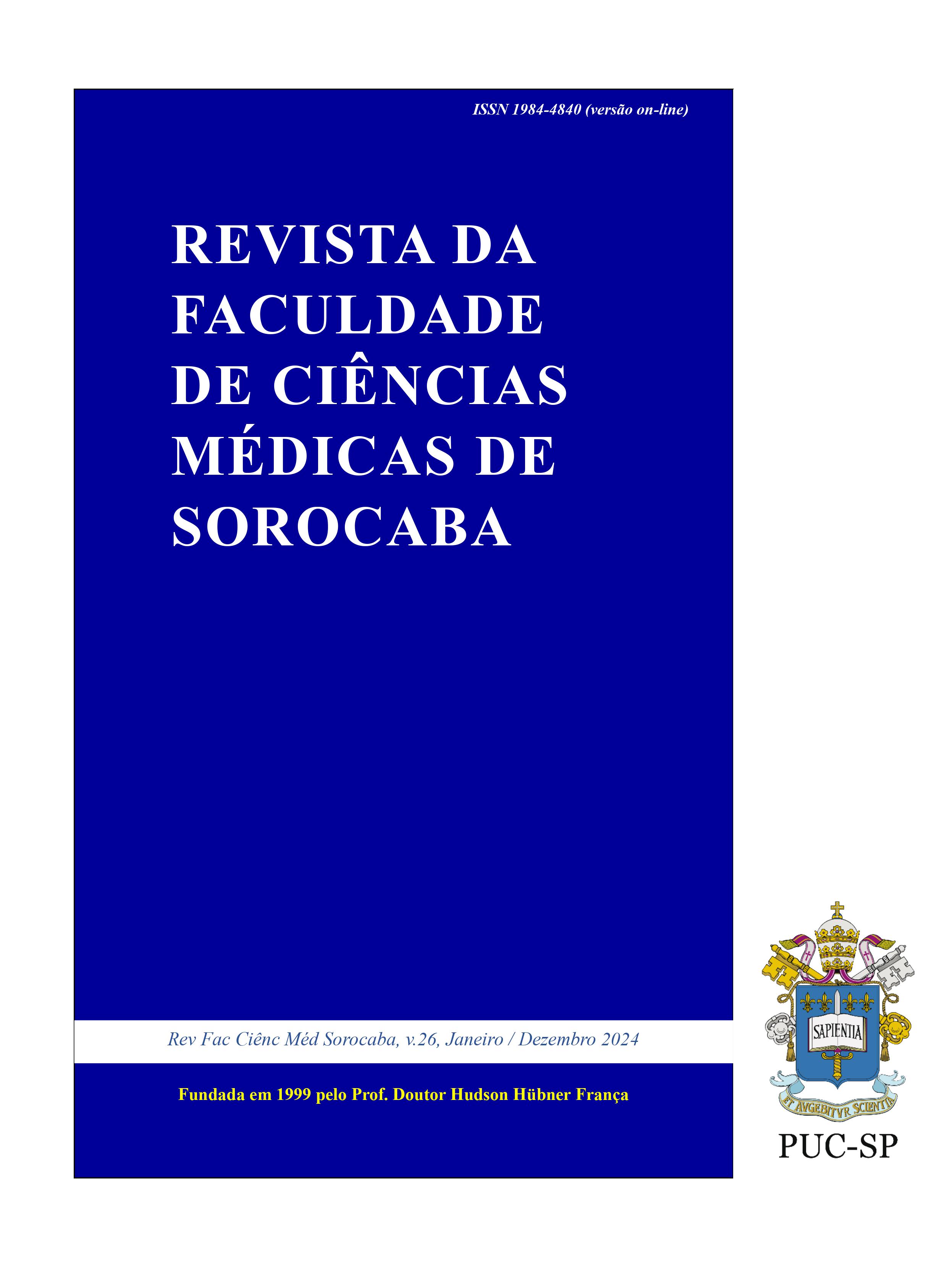FODMAP content in meals at a university restaurant and the presence of gastrointestinal symptoms among students
DOI:
https://doi.org/10.23925/1984-4840.2024v26a19Keywords:
FODMAP Diet, Oligosaccharides, Restaurants, University, Students, Gastrointestinal DiseasesAbstract
Objectives: to verify the presence of gastrointestinal symptoms in student using a university restaurant, in addition to identifying the FODMAP content of the menus offered and its relationship with the presence of symptoms. Material and Methods: observational and cross-sectional study that included 28 students from a public university in the city of Santos, SP,
Brazil. Data collection took place between March and April 2022. Students responded to an (on-line) form with sociodemographic questions, intestinal habit (stool typology) and gastrointestinal manifestations, occurring within 24 hours of eating the meal. The FODMAP content of the menus was evaluated, considering: low content; moderate content and high content. Results: of the participants (n=28), 28.6% were male; the age ranged between 18 and 26 years. The majority of students (n=12) reported a bowel movement pattern between constipation and diarrhea. Among the other manifestations, 78.5% (n=22) reported abdominal pain/stomachache; 57.1% reported flatulence and 42.8% diarrhea and/or urgent bowel movements. As for the menus (14), more than half (n = 8) contained a high FODMAP content. Symptoms appeared between four and six hours after the meal among more than 50% of students who reported symptoms (n = 6). Conclusions: meals with moderate and high FODMAP content were related with the presence of gastrointestinal manifestations such as abdominal pain, flatulence, diarrhea and bowel movement urgency, within 24 hours after consumption among university students.
References
Andrade VLA, Fonseca TN, Gouveia CA, Kobayashi TG, Leite RGS, Mattar RA, et al. Dieta restrita de FODMAPs como opção terapêutica na síndrome do intestino irritável: revisão sistemática. GED Gastroenterol Endosc Dig. 2015;34(1):34-41.
Makharia G, Gibson P, Bai J, Crowe S, Karakan T, Lee YY, et al. Diet and the gut. J Clin Gastroenterol. 2022;56(1):1-15. doi: 10.1097/MCG.0000000000001588.
Almeida LB, Marinho CB, Souza CS, Cheib VBP. Disbiose intestinal. Rev Bras Nutr Clin. 2009;24(1):58-65.
Passos MCF, Moraes-Filho JP. Microbiota intestinal nas doenças digestivas. Arq Gastroenterol. 2017;54(3):255-62. doi: 10.1590/S0004-2803.201700000-31.
Drossman DA. Functional gastrointestinal disorders: history, pathophysiology, clinical features and Rome IV. Gastroenterology. 2016;150:1262–79. doi: 10.1053/j.gastro.2016.02.032.
Souza GS, Sardá FAH, Giuntini EB, Gumbrevicius I, Morais MB, Menezes EW. Tradução e validação da versão brasileira do questionário Gastrointestinal Sympton Rating Scale (GSRS). Arq Gastroenterol. 2016;53(3):146-51. doi: 10.1590/S0004-28032016000300005.
Federação Brasileira de Gastroenterologia. Dieta com baixo teor de FODMAPS [Internet]. Disponível em: http://www.fbg.org.br/Publicacoes/noticia/detalhe/5
Aufieri MC, Morimoto JM, Viebig RF. Severity of irritable bowel syndrome symptoms and FODMAPs intake in university students. Arq Gastroenterol. 2021;58(4):461-7. doi: org/10.1590/S0004-2803.202100000-84.
Gorgulho BM, Lipi M, Marchioni DML. Qualidade nutricional das refeições servidas em uma unidade de alimentação e nutrição de uma indústria da região metropolitana de São Paulo. Rev Nutr. 2011;24(3):463-72. doi: 10.1590/S1415-52732011000300009.
Universidade Federal de São Paulo. Campus Baixada Santista. Cartilha do restaurante universitário: uma opção saudável [Internet]. Disponível em: https://www.unifesp.br/campus/san7/images/pdfs/Cartilha_RU__2018_atualizada.pdf
Gibson PR, Shepherd SJ. Evidence-based dietary management of functional gastrointestinal symptoms: the FODMAP approach. J Gastroenterol Hepatol. 2010; 25(2):252-8. doi: 10.1111/j.1440-1746.2009.06149.x.
Hayes PA, Fraher MH, Quigley EM. Irritable bowel syndrome: the role of food in pathogenesis and management. Gastroenterol Hepatol. 2014;10(3):164-74.
Zanetti AJA, Rogero MM, von Atzingen MCBC. Low-FODMAP diet in the management of irritable bowel syndrome. Nutrire. 2018;43:17. doi: 10.1186/s41110-018-0076-z.
Ong DK, Mitchell SB, Barrett JS, Shepherd SJ, Irving PM, Biesiekierski JR, et al. Manipulation of dietary short chain carbohydrates alters the pattern of gas production and genesis of symptoms in irritable bowel syndrome. J Gastroenterol Hepatol. 2010;25:1366-7. doi: 10.1111/j.1440-1746.2010.06370.x.
Magge S, Lembo A. Low-FODMAP diet for treatment of irritable bowel syndrome. Gastroenterol Hepatol (NY). 2012;8(11):739-45.
Downloads
Published
How to Cite
License
Copyright (c) 2024 Revista da Faculdade de Ciências Médicas de Sorocaba

This work is licensed under a Creative Commons Attribution-NonCommercial 4.0 International License.
Os autores no momento da submissão transferem os direitos autorais, assim, os manuscritos publicados passam a ser propriedade da revista.
O conteúdo do periódico está licenciado sob uma Licença Creative Commons 4.0, esta licença permite o livre acesso imediato ao trabalho e que qualquer usuário leia, baixe, copie, distribua, imprima, pesquise ou vincule aos textos completos dos artigos, rastreando-os para indexação, passá-los como dados para o software, ou usá-los para qualquer outra finalidade legal.

 Este obra está licenciada com uma Licença
Este obra está licenciada com uma Licença 